 — Recommendations are independently chosen by Reviewed’s editors. Purchases you make through our links may earn us a commission.
— Recommendations are independently chosen by Reviewed’s editors. Purchases you make through our links may earn us a commission.We've added new products to this guide, including our new Best Value pick, the Crock-Pot Express Easy Release 6-Quart Pressure Cooker, and our Best Upgrade pick, the Chef iQ. The Instant Pot Ultra 10-in-1 remains our Best Overall.
An electric pressure cooker, like our favorite Instant Pot Ultra (available at Amazon for $139.99), can transform a weeknight dinner routine and expand your cooking program whether you're single or cooking for a large family. Meals that used to take an hour now take 20 minutes, and recipes that once dirtied all of your pots and pans now only require you to wash a pot, a lid, and your cutting board.
Electric pressure cookers—also known as multicookers—are countertop appliances that combine the functions of an old-school stovetop pressure cooker, slow cooker, rice cooker, yogurt maker, and more in one unit of efficiently released pressure. It allows you to cook almost anything you’d like in a single pot, from boiled eggs to entire dinners, quickly and without overheating in a pot. You can think of it as a one-stop-shop.
Since these devices can do so much, we put Instant Pot to the test against other manufacturers to see who really makes the top appliance. We judged them on ease of use, how tough they were to clean, how smooth the pressure release valve was, and, of course, how well the food turned out. While Instant Pot remains our best overall, we also loved the Crock-Pot Express Easy Release 6-Quart Pressure Cooker (available at Target) as our best value pick and we were super impressed by our upgrade pick, the Chef's IQ (available at Amazon), for its minimal design and customizable cook functions.
(Looking for more tips? Here’s everything you need to know to use a pressure cooker).
These are the best pressure cookers we tested, ranked in order:
- Instant Pot Ultra
- Crock-Pot Express Easy Release 6-Quart Pressure Cooker
- Chef iQ
- Instant Pot Smart Wi-Fi
- Instant Pot Duo Plus
- Ninja Foodi Pressure Cooker, Steamer & Air Fryer
- Instant Pot Duo Crisp
- Taotronics TT-EE007 Multicooker
- Instant Pot Duo
- Midea MY-SS6062
- Breville Fast Slow Pro Pressure Cooker
- GeekChef 11-in-1 Multi-Functional Pressure Cooker
- Black and Decker Electric Multicooker
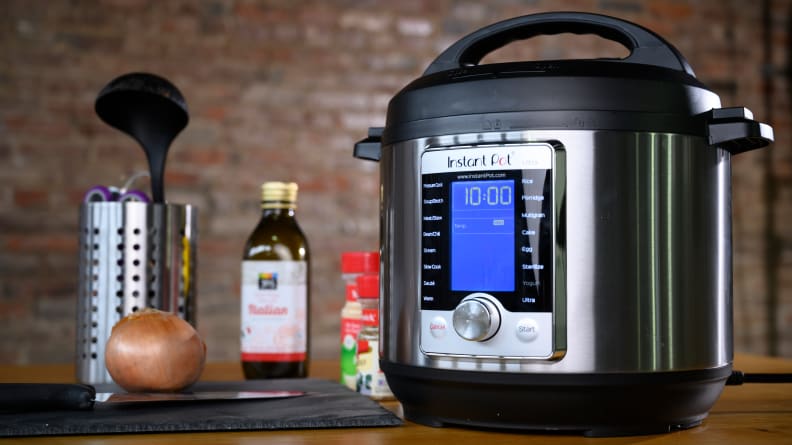

The Instant Pot Ultra is our favorite pressure cooker overall.
The Instant Pot Ultra still reigns supreme in terms of versatility, ease of use, and price for this new round of tests (though our former favorites are still worth the money). Performing extremely consistently across meat cookery with tender, juicy results, rice cooking, plus slow cooking, and its preset Yogurt function (which can be also repurposed for general fermentation). This Instant Pot will easily suit all your pressure cooking needs and more.
This Instant Pot offers some nice aesthetic and exterior updates to the more basic Duo or even the Smart Wi-Fi with its display graph, showing you exactly where it is in the pre-heating, cooking or keep warm cycle. The new knob design, versus buttons, and “+/-“ keys, are sleeker than before. And perhaps best of all, the release valve no longer requires a slightly hazardous manual push from an arm’s distance with chopsticks or tongs; there’s a switch you can flip next to the valve to get it started.
In terms of functionality, the Ultra offers some extra settings: Sterilize, Cake Maker, Egg Cooker, and Ultra. You could mimic most of these with the Duo or Smart Wi-Fi, but the Ultra offers a slightly more precise set of criteria for these if you happen to make a lot of cakes or egg bites in your pressure cooker. The “Ultra” feature is meant to allow maximum customizability, and you’re able to control the temperature inside the pot this way to use this as a sous vide machine.
While this version of the Instant Pot doesn’t connect to an app, you can always use the manual Delay Start function to pre-plan your cooking needs and browse the Instant Pot app or the multitude of online Instant Pot communities for recipes and tips.
Pros
-
Cooks perfectly
-
Intuitive to use
-
Easy to clean
Cons
-
Not "smart"
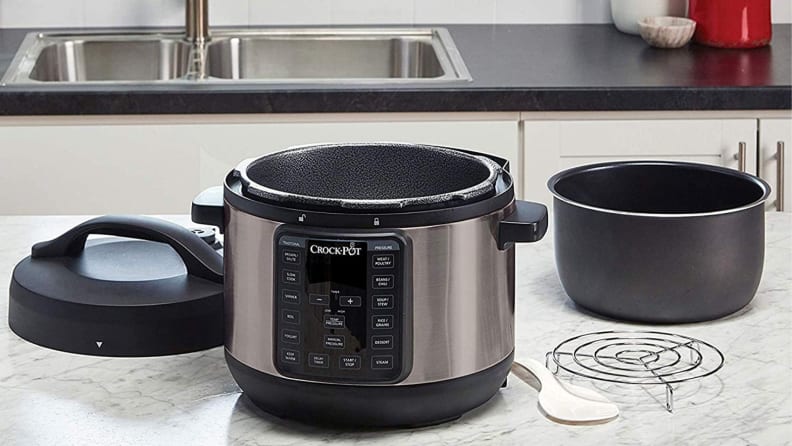

This spacious multicooker is our budget pick.
If you’re shopping for a budget pressure cooker, the Crock-Pot Easy Release is worth your consideration. A replacement for an older model that was recalled, this multicooker’s sleek brushed steel exterior is super easy to clean, and we wouldn’t mind leaving it on display either.
While this model isn’t touchscreen, the dials are relatively intuitive. Features include the Progress Bar that allows you to monitor pressurization and preheat status before cooking begins along with 11 cooking presets including Yogurt, Beans/Chili, Meat/Poultry, Slow Cook, Rice/Grains, and more. Additionally, pressurization, time, and temperature are all customizable by using the manual settings.
This cooker is equipped with a spacious 6-quart inner pot that we felt would be large enough to cook meals for a big family. Beyond the impressive cooking capacity, this Crock-Pot also excelled in the chili, chicken, risotto, and yogurt tests.
In terms of safety features, we liked the locking mechanism that makes sure the lid won’t be accidentally opened when the cooker is pressurized. This would be especially helpful for a family with small children. Its Easy-Release switch also made depressurization stress-free. Though the user manual suggested that it may take up to 20 minutes to depressurize, in reality it took less than 10 minutes.
However, this multicooker isn’t without its disadvantages. During one of our tests, we received an error code “E6” and consulted the user manual to find answers—thankfully, there’s an explanation for each error code that may pop up. After troubleshooting using the guidance provided by the manual, we were able to continue testing.
Another minor inconvenience is its size. We had no problem lifting and moving it around the kitchen but it’s a bit too tall for our tester, who’s 5’2’’. She was standing on her toes trying to look inside the pot after it was done cooking.
Pros
-
Cooks well
-
Easy to clean
-
Tons of features
Cons
-
Oversized
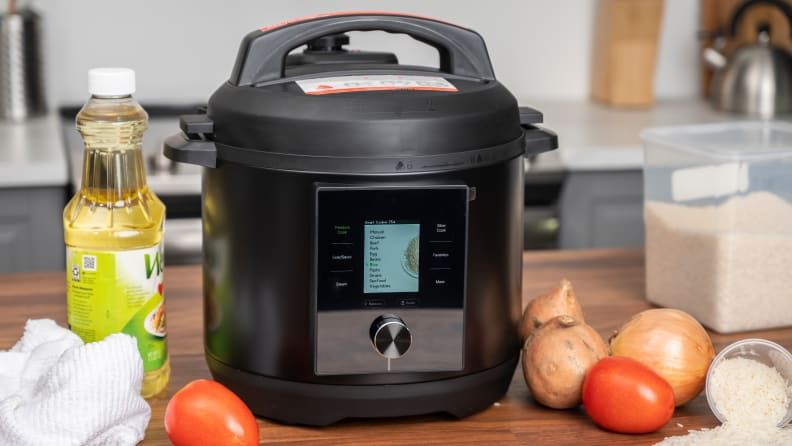

The Chef iQ is designed for chefs by chefs, and it's our pick for best upgrade pressure cooker.
We loved the Chef iQ smart cooker for its gorgeous build—minimalist black both inside and out with a simple screen and black knob—and customizable cook functions. You can dictate almost all aspects of each setting; for example, its Ferment function allows you to adjust the fermentation temperature, making it more versatile than the preset Yogurt function on the Instant Pot.
Designed for chefs by chefs, this pressure cooker offers some small but impactful details. It has a built-in tare function, for example, so you can weigh ingredients directly into the pot and minimize dishes from building up in the sink. It also removes the guesswork during the initial pressurizing phase by displaying exactly how much pressure has built up in the cooker, so anxious cooks can more accurately estimate how long it’ll take until dinner is ready.
Plus, you can choose when and how pressure is released after cooking, so if you opt for immediate quick release, the cooker will automatically beep to let you know it’s about to release pressure and then do it for you for a totally hands-free experience.
This pressure cooker also connects easily to the Chef iQ app, which is beautifully designed and full of recipes and tips. It’s not required for you to sync the two before use, so you can add on the app at any point. However, this cooker is significantly more expensive—clocking in at $50 more than our overall best pick—so we’ll leave that final decision to you.
Pros
-
Sleek, attractive design
-
Customizable settings
-
Built-in weighing functionality
-
Hands-free pressure release
Cons
-
None that we could find
How We Tested
The Testers
Hi, I'm Jenny! I'm a professional chef, writer, founder of a nonprofit community think tank called Studio ATAO, and author of Mastering the Instant Pot. I've been a pressure cooker fan since way before Instant Pots were a “thing”—pressure cookers have been a staple in my mother's kitchen for making flavorful stocks, tender braises, and creamy porridge for decades. In fact, it's the first appliance she bought for me when I moved to a new city after college.
And we’re Bethany, Cassidy, and Valerie. All of us love to cook but work full-time, so coming home and having to prep dinner and lunch for over an hour gets exhausting, fast. Needless to say, we're pressure cooker fans—and having each contributed to this piece more than once, we know our stuff.
Bethany tackled the initial pressure cooker research and product round-up in late 2017. Cassidy updated this article in December 2018 (almost a year after its initial publication) to include three new models, then Bethany came back to add a new slow cook test and four new models. Jenny completed the most recent round of major testing and Valerie rounded out the bunch by testing the new Crock-Pot.
Before selecting our final list of multicookers, we looked at a total of 20 Instant Pots and competitors. We passed over some of the earlier Instant Pots like the Instant Pot Lux, as the newer models (like the Instant Pot Smart Wi-Fi) offer features we wanted to check out. Otherwise, we chose the ones with the best combination of high reviews, great features, and reasonable pricing. (If a multicooker was twice the price with half the features, it didn’t make the cut.)
We exclusively tested moderately sized 6-quart Instant Pots and other multicookers, although you can find many of these multicookers in 3- to 8-quart models. The 8-quart models are better for large families.
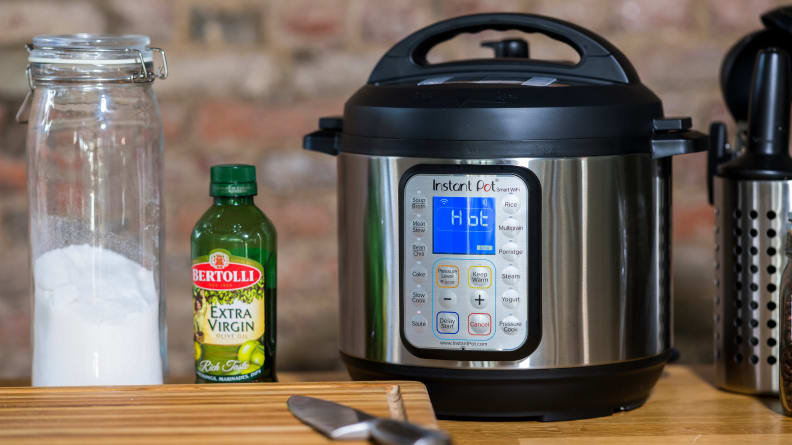
We like the Instant Pot Smart Wifi because it's a smart device with tons of features.
The Tests
To ensure each pressure cooker was a good all-rounder, we tried three recipe types in our first round of testing: a classic comfort food (chicken noodle soup), a date night special (saffron risotto), and a finicky breakfast bowl (yogurt from scratch). We added a slow cooker chili in subsequent updates to see how these appliances measured up to a traditional slow cooking device. We used the same ingredients for each and took detailed notes about how easy or difficult it was to select the cooking functions and times, how the food came out, and how tough the pressure cooker was to clean.
We also noted any surprises. Did the milk heat up to the right temperature for making yogurt? Did the Instant Pot flash a weird symbol during cooking? Did the steam valve spray hot milk everywhere and startle us so much we accidentally threw a recipe book across the room?
For cleaning, we did everything by hand.
We also took into account how helpful the manual was (and how much we needed to use it while cooking), whether or not it came with a recipe book, whether or not you could manually set cooking temperature and pressure rather than rely on cooking programs, and whether or not those cooking programs functions worked as expected. All of these were important in assessing the overall ease-of-use for these pressure cookers.
One of the nice things about these appliances is that with enough time spent consulting the manual and Googling your questions, you can figure out even the most confounding of tasks. That said, if a cooker left me wondering whether or not our food would be edible when it was finished, we took that into account.
We also quickly learned that you should have all of your ingredients ready to go before even turning on your pressure cooker. These things work fast, so your ingredients should be prepped before you start.
What Is The Difference Between Pressure Cooker, Slow Cooker or Multicooker?
Given how many different types of kitchen gadgets are on the market these days, it’s helpful to know the difference between a pressure cooker, a slow cooker, and a multicooker. In brief, a slow cooker—often referred to as a Crock-Pot—cooks or simmers food at a relatively low temperature for a long time. It’s frequently used to make stews, briskets, or anything that you might want to prep before heading out for the day and eat when you get home from work.
A pressure cooker speeds up this process by sealing food and liquid in a pot and using the trapped steam from cooking to quickly raise both the temperature and pressure. Once the food is cooked, you can release the steam via a small valve, allowing you to open the sealed container. Pressure cookers are great for quickly making a meal that would otherwise take an hour or two. Older pressure cookers—think pre-Instant Pot craze—went directly on the stove, but these days they’re largely electric and live on your counter.
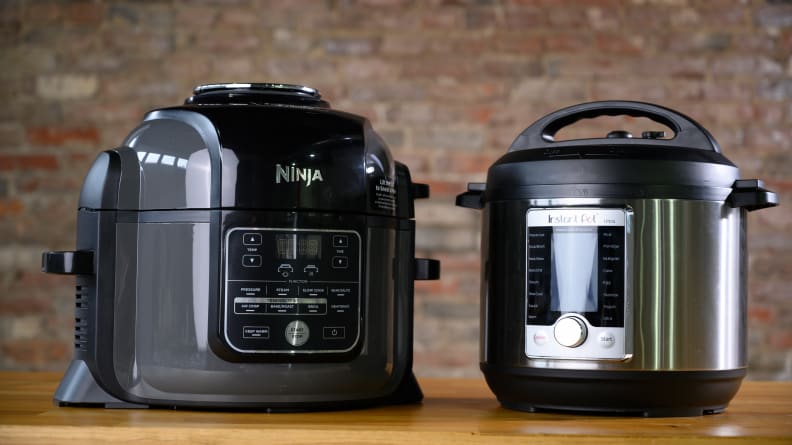
The Ninja Foodi Pressure Cooker are Instant Pot Ultra are both multi-cookers that can do a lot more than slow cook—the Ninja can ever air fry.
A multicooker is simply an electric cooking device that combines multiple functions, such as slow cooking and pressure cooking and yogurt making, into one device.
In our experience, most electric pressure cookers—including the Instant Pot—are actually multicookers. But before you buy one, make sure it has the functions that you’re most likely to use. For instance, if making yogurt at home is important to you, check to be sure your pressure cooker has that function (since making yogurt relies on a totally different capability than pressure cooking). These gadgets are extremely versatile, and ideal for quick cooking when you don’t want to dirty all of your pots and pans—or don’t want to turn on your oven. They're also great for large families who need to cook for a lot of people at once.
Other Pressure Cookers We Tested
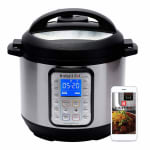

The recently-released Instant Pot Smart Wi-Fi is everything a multicooker can (and should) be: fast, efficient, precise, intuitive, and perfectly capable of replacing most other devices in your kitchen. The Smart Wi-fi is Instant Pot’s update to the Smart Bluetooth, a middling product that suffered from poor app maintenance and connectivity issues. Luckily, this version faces none of those issues, and instead provides a handy 8-in-1 appliance with the convenience of Wi-Fi connectivity, allowing you to set, monitor, and control your multicooker from virtually anywhere. Beyond this new technology, the Smart Wi-Fi shares most of its DNA with the existing Duo Plus, save for the latter’s Sanitize function.
If a smart-connected device sounds too complicated to have in the kitchen, don’t worry—the Instant Pot Smart operates just fine without the app, too. While we did use the app at points throughout testing, we usually fell back into entering controls manually (this is our job, where else did we have to be?) and found it incredibly easy to use. Our coworkers and Cassidy's housemates loved both the risotto and yogurt made in this Instant Pot and while the chicken for the soup was slightly “shredded” by the pressure-cooking process, the flavor of the final result was still strong. It’s worth noting that when the Instant Pot changes between modes, the beeps are LOUD, which can be helpful or annoying—but you can turn the sound off if you’re trying to sleep.
If you’re into micro-managing your dinner, this model also allows you to choose between “Less,” “More,” and “Normal” settings for each preset. If you’re not that kind of person, it also comes with 750+ pre-programmed recipes that simply let you press a button and forget about the meal until it's done, something no other multicooker can claim.
Pros
-
Cooks well
-
Smart device
-
Tons of features
Cons
-
Can be complicated to use
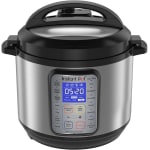
The Instant Pot Duo Plus 9-in-1 has 14-plus functions, including Steam, Sterilize, and Cake (if you want to compare models, check out our Instant Pot buying guide) . But if you start to feel overwhelmed, you can always Google your question and come away with an avalanche of blog posts, Facebook forums, and YouTube videos to guide your way. For novice cooks looking for a community to help with recipes and reassurance, this Instant Pot is perfect. (Fortunately, recipes designed for the Instant Pot work just as well with most other multicookers. You just won’t be able to chime into the Instant Pot-specific conversations.)
The reason there's a growing online community around this gadget is that it works like a charm. The soup we cooked tasted like grandma’s, the risotto was delightfully creamy, and the yogurt turned out tangy and bright. The Sterilize function was also a great bonus, helpful for preparing the pot to make yogurt—the only function missing on our top choice, the Smart Wi-Fi.
While it wasn't as intuitive as I would have liked—and the lid occasionally tripped me up—I have a feeling this Instant Pot could still edge out your current slow cooker, and your rice cooker, and your favorite steaming method and, you get the idea. If you’re looking for a comprehensive Instant Pot with a longer history and larger user base than the Smart Wi-Fi, this is your best bet.
Pros
-
Cooks well
-
Simple to use
Cons
-
Lacks features in other models
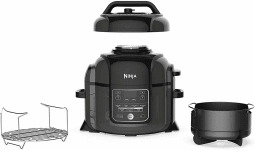

The Ninja Foodi is giant and more expensive than most of its competitors, but could hypothetically replace an oven for small kitchens or mobile spaces. In addition to a reliable pressure cooking functionality—easily making flavorful broths, succulent braises, and creamy risotto—it also can offer the dry-heat cooking that other pressure cookers simply cannot.
By far the biggest added benefit to the Ninja is the air crisper lid. Combined with the pressure cooking function, it can also do things like crisp up the skin of roast chicken, or get that nice golden-brown on a batch of fish-and-chips. While it works best to make dinner for one or two people (we tried batch cooking with this function and it worked, but not as well), it’s ideal if you don’t care about leftovers. Within 20 minutes, we were able to make a full meal that didn’t require pressure cooking—ultimately making this the most versatile multicooker yet.
With two different lids, one for pressure cooking and one for air frying and crisping, we were able to not only complete the chicken soup, veggie chili, and risotto tests with ease, we were also able to make a complete meal of rice with baked tofu and crisped veggies. The only tricky test was the yogurt, as this multicooker does not have a yogurt function. However, after a quick online search, we learned that you can use the dehydrate function to keep the yogurt at the proper temperature. So while a bit less creamy than the batches done with the Instant Pot, the Ninja made tasty yogurt even without a dedicated cooking program.
Pros
-
Cooks very well
-
Includes air fryer function
-
Versatile
Cons
-
Oversized

Likely built as the Instant Pot’s answer to the Ninja Foodi, this pressure cooker also boasts an Air Fry function through the use of separate lids (and you can remove and store the lids when not in use, unlike the Ninja). As with the Ninja, the Duo Crisp is a pressure cooker first and air fryer second; if you’re primarily looking for the latter, check out the best air fryers we’ve tested.
The Duo Crisp performed similarly to its Instant Pot counterparts in the standard functions. It does lack the Yogurt function, but offers a Sous Vide function in its stead—which could be more or less useful depending on what you need in the kitchen.
Pros
-
Easy to clean
-
Consistent, reliable results
-
Also offers air fry function
Cons
-
No Yogurt function
-
Large

If you told us that the TaoTronics TT-EE007 Electric Pressure Cooker was a new Instant Pot model that had the wrong name printed on it, we would believe you. The sleek, sophisticated cooker has a panel almost identical to that of the Instant Pot Duo Plus, and its blue-on-black display is even more attractive, with all necessary information displayed clearly. I was also consistently impressed by this multicooker's speed and power—its sauté function worked like a charm, it got milk even hotter (without boiling) than the Instant Pot when it came time to make yogurt, and it produced some seriously flavorful risotto.
But what the TaoTronics model has in power it seems to lack in some precision and control, which resulted in slightly-lumpy yogurt and overcooked chicken noodle soup. The hot heat of the pot also made it harder to clean at the end of each test, because there were often bits of burnt food stuck to the bottom. It’s a powerful, attractive cooker that can do just about anything the Duo Plus can, but you might not get the same perfect precision with all your recipes.
Pros
-
Fast
-
Powerful
-
Simple to use
Cons
-
Not very precise with temperatures
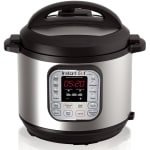
The Duo remains one of Instant Pot’s top sellers—making it a worthwhile test. But after putting the Duo through its paces, we have to say that it ranks firmly in the middle of the pack.
The Duo made good soup and decent risotto but flubbed on the slow cooker chili. Even after 12 hours of slow cooking, the onions were not cooked and the chili was more soup than a thick stew. It also struggled with yogurt, unable to bring the milk up to the proper temperature without switching out of the yogurt function and into sauté. It was also the slowest to come up to pressure during cooking, often leaving me to wonder if we had set it correctly at all. With so many other options on the market—including new Instant Pots—we would personally skip the Instant Pot Duo in favor of a slightly more robust pressure cooker.
Pros
-
Simple to use
-
Affordable
-
Cooks fine
Cons
-
Slow to pressure
-
Cooks chili and yogurt poorly
-
Lacks features in other models
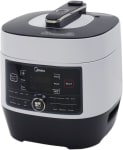
Though the Midea MY-SS6062 looked quite different from the other multicookers—a white cube in a world of circular silver pots—its performance was undistinguished. The circular dial, menu display, and unhelpful manual made it tougher to use than more conventional rivals. We spent a fair bit of time guessing whether or not we were cooking something correctly, just hoping that we hadn't ruined the food. Everything ultimately tasted fine, but the inability to adjust the time of certain cooking functions (for instance, yogurt is stuck on six hours when most recipes call for almost 10), bumped this one down the list.
Pros
-
Cooks fine
-
Interesting design
Cons
-
Difficult to use
-
Lack of useful controls
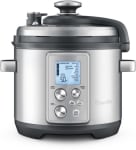
We were honestly disappointed by the Breville Fast Slow Pro Pressure Cooker. While it was a favorite out of the box due to the beautiful, easy-to-use interface, multitude of smart programs, and attached lid, it ultimately fell toward the bottom of the pack. We had to consult the manual while making the soup (ultimately ending up with tougher vegetables than the recipe indicated), and despite a seemingly endless array of cooking options, there was no yogurt function at all.
And unlike the Ninja multicooker, we were unable to produce yogurt with the functions that were available. In a similar vein, we loved the idea of an attached lid, but the reality was rather frustrating. It took twisting the lid a very particular way to get it to close, which we could never seem to get right on the first or even third try.
On the positive side, the interface and recipe options were phenomenal. Similar to the Instant Pot Ultra, the scroll through the interface was easy to use and offered a lot of cooking options. It has an auto-release steam valve, which means that in the pre-programmed recipe when it’s time to release steam from the pressure cooker, it does so automatically. This makes the Breville a true set-and-forget cooker—but only if you were using one of its smart programs. For its high price point, we were expecting much better.
Pros
-
Attractively designed
-
Intuitive interface
Cons
-
Overpriced
-
Lacks many features
-
Difficult to use
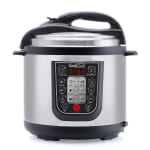
The GeekChef 11-in-1 Multi-Functional Pressure Cooker looked just like the other models but constantly kept us on our toes. Regardless of the recipe, we always had to consult the manual, and even after doing so, we were never quite sure whether we were doing it right. So while the food turned out well, the cooking process was a guessing game that required us to cobble together hybridized instructions from Instant Pot tutorials we found online. The GeekChef also didn’t provide as much flexibility with pre-set cooking functions as we would have liked, as there were minimum times for some functions, which meant we needed to set a timer.
Pros
-
Cooks fine
Cons
-
Difficult to use
-
Lack of useful controls
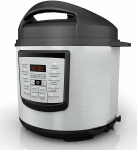
Another nonstick model in our round-up, the Black and Decker Electric Multicooker was a breeze to clean after every one of our tests. Unfortunately, clean-up was one of the only areas in which it excelled. The risotto turned out more like plain paella rice than creamy risotto despite following the recipe book’s directions, the soup was full of overcooked veggies, and the pot consistently took a longer time than other cookers to get to the desired temperature and pressure.
So, why the issues? While the Black and Decker model looks a lot like the standard, Instant Pot-esque multicooker in terms of design, it lacks most of the buttons and functionality that make these devices so appealing—common functions like Sauté and Pressure Cook have been replaced by Browning and Manual, even though the manual control doesn’t allow you to alter the temperature or degree of pressure. Oh, and there’s no Yogurt button at all—so you may as well make your breakfast on the stovetop. While my yogurt came out fine, we didn’t appreciate having to do it the old-fashioned way (with constant stirring and temperature-taking) inside a shiny new device.
Between the lack of features, the odd chemical smell that came from the pot while sautéing the onions for risotto, and the absence of alert noises that made us forget to depressurize at the right time, the Black and Decker multicooker has a lot of room for improvement.
Pros
-
Easy to clean
Cons
-
Slow to pressure
-
Cooks poorly
-
Lacks common features

